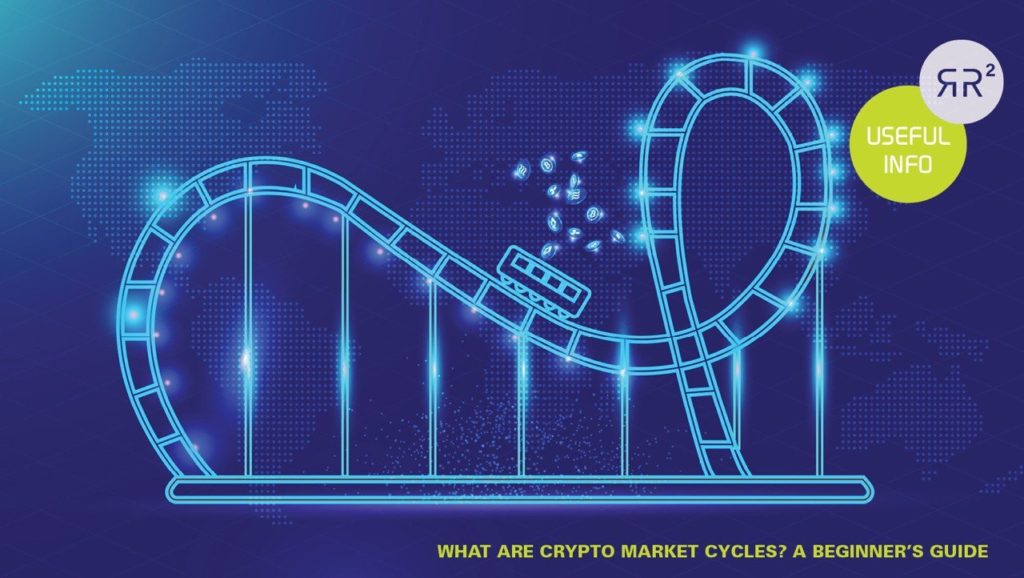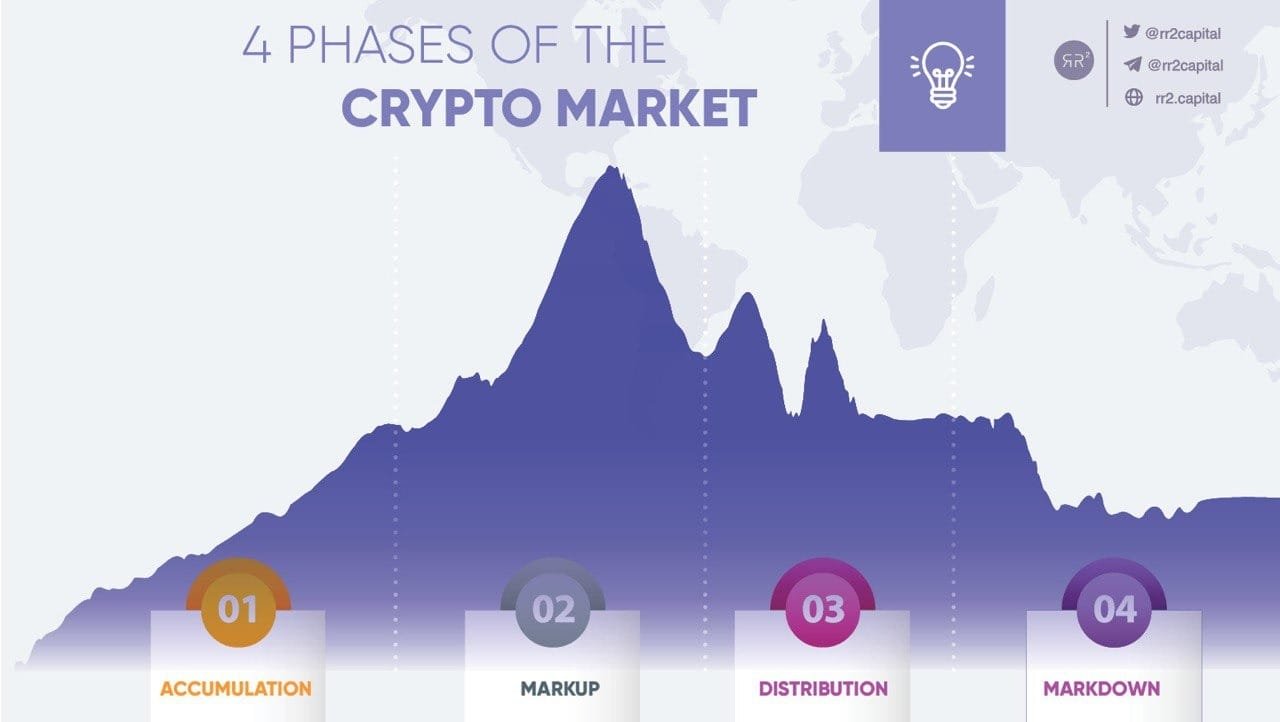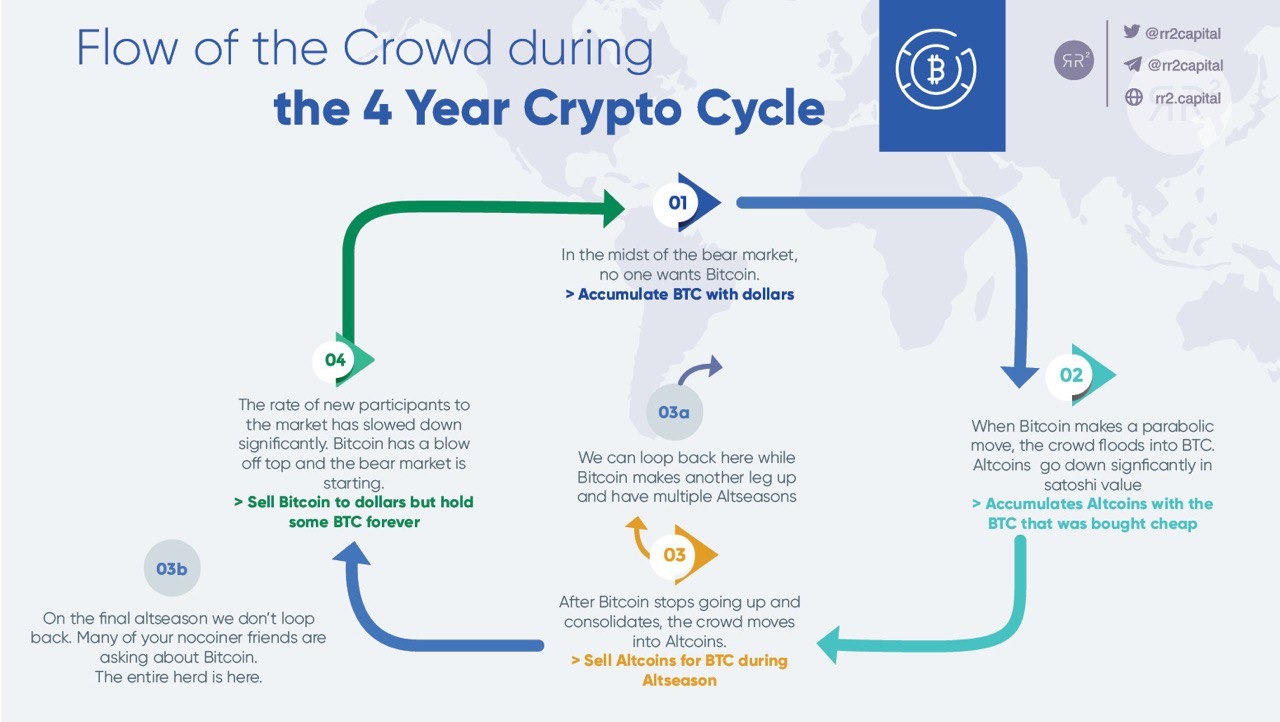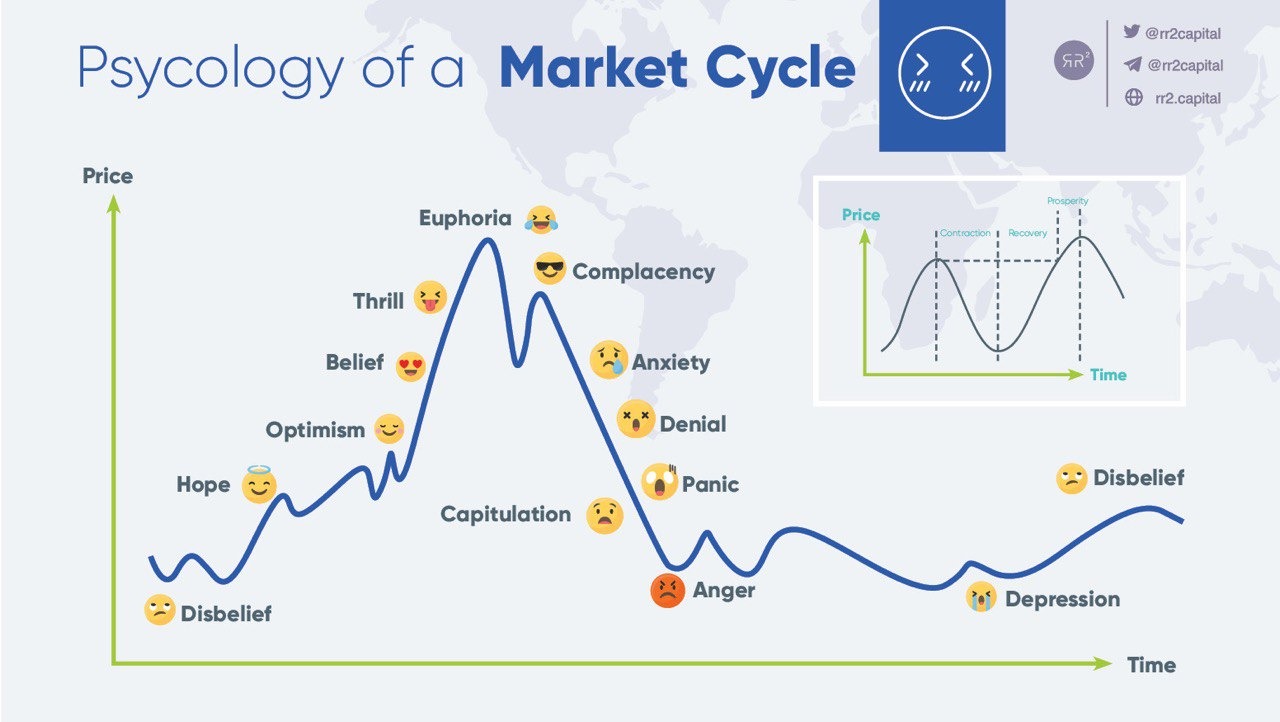Crypto market cycles refer to the fluctuations in the value of cryptocurrencies over a period of time.
Cryptocurrencies, such as Bitcoin, are known for their volatility. Their prices can fluctuate wildly within very short periods of time, making it difficult to predict their value. However, over time, these fluctuations tend to follow a pattern, with periods of rapid growth followed by corrections or downturns. These cycles are known as cryptocurrency market cycles.
Market cycles are usually characterized by periods of growth, followed by corrections or downturns. Understanding market cycles is important. A good understanding can help an investor make informed decisions about when to buy and sell their crypto.
The 4 Phases Of A Crypto Market Cycle
Unfortunately, within the crypto industry, beginners tend to believe that the price will only continue to rise. Beginner crypto traders often don’t take market cycles into consideration when trading. Market cycles are a normal part of any market, to which the cryptocurrency market is not immune.
Market cycles are a natural phenomenon that occurs in every market, the crypto market is no different. Regardless of what market you are referring to, they all go through the same phases. Each market cycle typically consists of four phases: the accumulation phase, the markup phase, the distribution phase, and the markdown phase.
Here are the four components of a crypto market cycle and how to recognize them:
-
The Accumulation Phase
The accumulation phase is the first phase of a market cycle. Every market cycle begins with an accumulation phase.
The accumulation phase starts at the end of the preceding cycle. This is once most sellers have left the market, and when prices begin to stabilize. This is the beginning of the new cycle which is often where prices are at their lowest. This is the stage that many refer to as “buying the dip”. The overall market sentiment during this phase starts to switch from negative to neutral.
This phase generally comes after a large downward trend and indicates the end of the trend. Some traders believe this point is still too risky to enter the market because there is still a possibility of a downward continuation. On the other hand, seasoned investors and traders will see this phase as a good indicator of a bull run.
This phase is characterized by lower volatility and is a good time to buy the dip. The accumulation phase is the perfect opportunity for long-term investors to enter the market. Buying and holding from this phase can bring about great returns.
-
The Markup Phase
The markup phase, also known as the bull market phase, is the phase of the market cycle in which prices start to rise. New groups of market participants enter the market during the markup phase. There is typically a noticeable increase in trading and market volume. During the markup phase, the market is generally characterized by a bullish sentiment.
Media attention starts to increase and the press starts to produce positive headlines. The demand for a particular asset starts to surpass the supply of that asset, which ultimately leads to an increase in the value of the pricing.
As this phase starts to mature, more investors start to buy in, as FOMO (fear of missing out) starts to kick. More investors are experiencing FOMO, buying near the top.
This is where smart money and insiders start unloading their bags. They view these smaller dips or pullbacks as opportunities rather than warning signs. The hype almost becomes so real that people believe the market will continue to rise.
While there is widespread excitement during this phase, there’s no guarantee that the prices of an asset will continue to rise.
-
The Distribution Phase
The distribution phase is the third phase of a market cycle. This is where both fear and greed run rife. It’s inevitable, at some point in a market cycle, buyers start to become sellers. So much so that an equilibrium is reached. This is the distribution phase.
During this phase, there are two sides. There are those who have confidence in the bull market and are still looking to buy. And on the other hand there are those who have lost confidence in the market and are looking to sell and lock in their profits. This is why the distribution phase is known as the most volatile. Prices can often stay locked in a trading range for months, but eventually, one side gives in.
The distribution phase is often regarded as the first sign of weakness of a bull market. This is usually a sign that a downtrend may be coming. At this point the smart money has already exited and the market is made up of fear, greed and anticipation.
This phase usually marks the very top of a bull market and is when the market begins to reverse and the bear market comes into sight.
-
The Markdown Phase
Eventually, the sellers begin to overtake buyers. This is known at the start of the markdown phase, or the bear market. The markdown phase starts as soon as the supply of an asset exceeds its demand.
The markdown phase is fueled by fear in the market. The market sentiment becomes increasingly negative and many investors start to lose hope. During this phase, the market is characterized by fear and panic. The media turns negative as prices continue to fall and the market reverses.
This phase is psychologically difficult for most investors, especially newbies. Many people land up selling too late or at a loss, while others end up trying to hold their crypto until the next markup phase.
Always remember: There have been cycles in the past, and there will continue to be cycles in the future. All markets have a natural inclination to follow this pattern. The good news is that as soon as one cycle is through, another one will start.
Which Phase Of A Market Cycle Is The Best To Buy?
The accumulation phase is the best time to buy into the crypto market. In this phase, prices are often at their All-Time Lows (ATLs) which often attracts investors. This phase presents investors with great opportunities. Investors who believe in the long-term potential of a particular crypto may choose to buy it at a lower price, in anticipation of future growth.
The best time to buy during a market cycle will depend on your individual circumstances and investment strategy. It’s important to carefully research and consider your options before making any investment decisions.
Which Phase Of A Market Cycle Is The Best To Sell?
The distribution phase, just before the previous phase turns (markup phase), is the best time to sell. This is when the market sentiment is the most bullish, prices are still climbing, often reaching new All-Time Highs (ATHs). This is when the smart money starts to sell.
At the end of the day, the best time to sell in a market cycle will rely on the specifics of your investment strategy and goals. For example, if you are looking at investing long-term, you may want to hold your assets through more than one market cycle.
How Long Does A Crypto Market Cycle Last?
The cryptocurrency market is highly volatile and can often be difficult to predict. It is often hard to predict exactly how long a market cycle will last. While the crypto market is still relatively young when compared to traditional markets, there is still some historical data to compare.
According to historical data, a crypto market cycle generally lasts roughly 4 years. It’s important to keep in mind that the length of a market cycle can vary depending on a variety of factors.
As mentioned above, the crypto market is still young and the historical data is scarce. While previous cycles may have lasted around 4 years, this may not always be the case. Market cycles are not perfectly predictable. The length and severity of each phase can vary, and there may even be multiple cycles within a single year.
What Factors Affect A Crypto Market Cycle?
There are various factors that can influence the length and direction of a crypto market cycle. Some of the most significant factors include:
- Investor sentiment
- Global economic conditions
- Regulatory changes
- Supply and demand
- Fiscal and monetary central bank policies
For example, a positive investor sentiment can drive up the price of digital assets, while negative sentiment can cause prices to decline. Similarly, regulatory changes can have a major effect on the crypto market, as can global economic conditions such as interest rates and inflation.
A market direction is never easy to predict. Never risk more than you can afford to lose.
Why Is It Important To Understand Market Cycles?
It’s important to understand market cycles for various reasons. Knowing and understanding how market cycles work can help investors make informed decisions about when to buy and sell their crypto. For example, if an investor knows when a market usually experiences a period of rapid growth, they may be more inclined to buy more just before this period. Further, if an investor knows what a cycle looks like when it’s about to experience a downturn, they can sell their assets before the price drops significantly.
Understanding market cycles can help investors manage their expectations and prepare for potential variations in market conditions. This can help investors remain calm and collective during periods of market volatility. This can be beneficial for an investor’s overall investment strategy.
Overall, understanding market cycles can help investors make informed decisions about when to buy and sell their assets. Market cycles are an important aspect of the cryptocurrency market and by understanding and anticipating these cycles, investors can make more informed decisions and potentially maximize their returns.
How To Take Advantage of Market Cycles?
Buy The Dip
A great way to take advantage of market cycles is to use a strategy known as “buy the dip”. This investment strategy involves buying crypto when prices are low, in the hopes of realizing a profit when the market recovers.
This strategy is based on the idea that market downturns are temporary and that prices will eventually rebound. When prices of assets are low, there are greater opportunities for investors to make a profit from their investments. If your investment plan is to hold onto assets for a longer period of time, buying the dip may be profitable once the cycle turns around.
As with any investment, always keep in mind that you should never risk more money than you are willing to lose. When compared to more traditional markets, the crypto markets exhibit significantly higher levels of volatility. No matter the phase of the market, the crypto market is notorious for its extreme degree of volatility.
Dollar Cost Averaging (DCA)
Dollar Cost Averaging (DCA) is an investment strategy that involves investing a fixed amount of money at regular intervals. These investments are made regardless of the current market conditions. DCA can help reduce the effects of short-term market volatility on your investments. DCA is not only used in the cryptocurrency markets, but also in traditional market analysis and investing.
One of the most significant benefits of DCA is the fact that it removes the element of emotion from investing. You don’t need to try to “time the market” or speculate about when prices will rise or fall. This can help you avoid making hasty decisions that are motivated by greed or fear, both of which can end up having negative repercussions for you.
It’s important to remember that while DCA can be a helpful investment strategy, it does not guarantee favorable returns. When it comes to investing, there is no such thing as a risk free investment. Always carefully research and consider your options before making any investment decisions.
About RR² Capital
For more information about RR² Capital and our expansive disruptive technology-focussed investment portfolio, visit our website here or send us a mail here.





